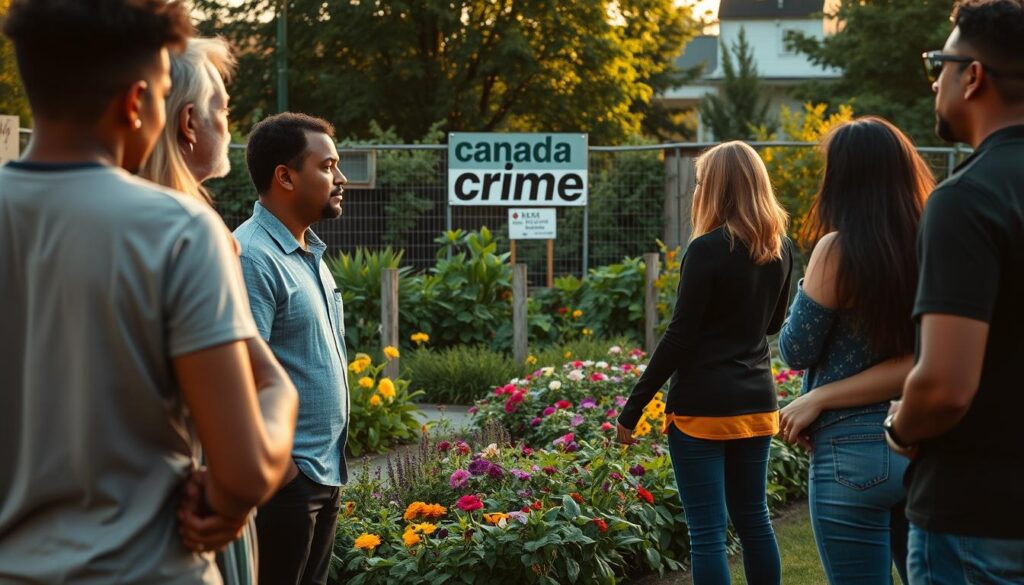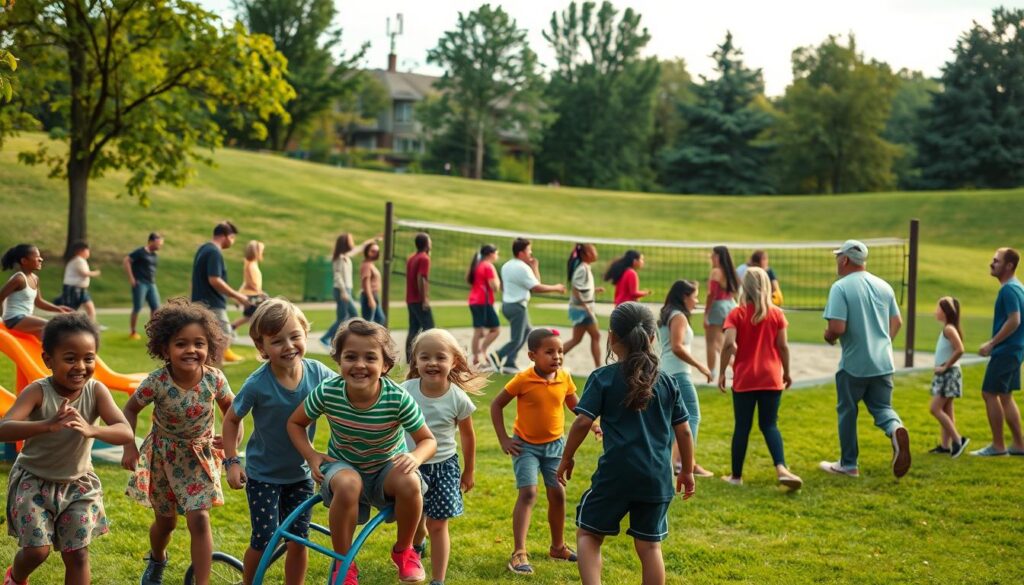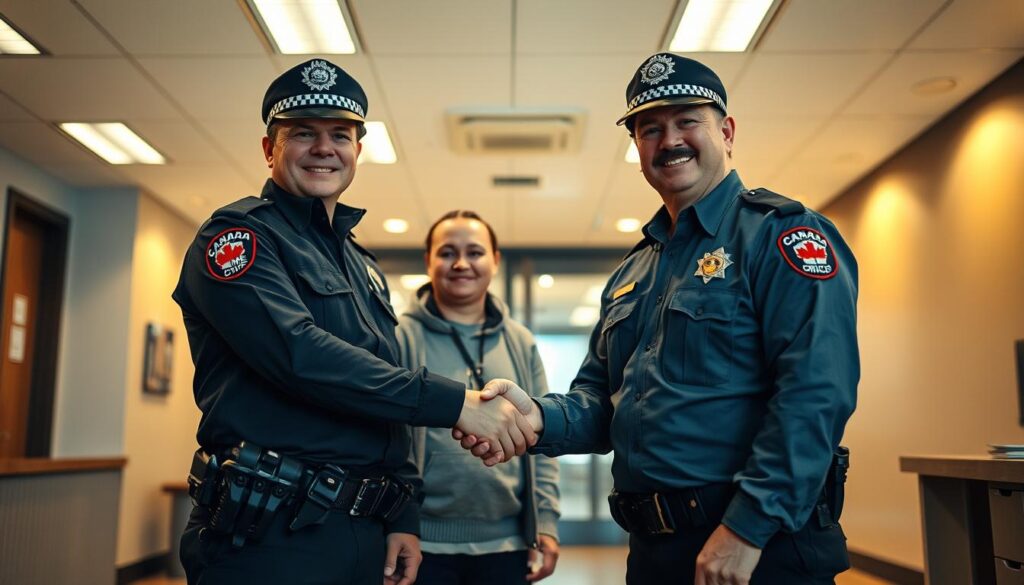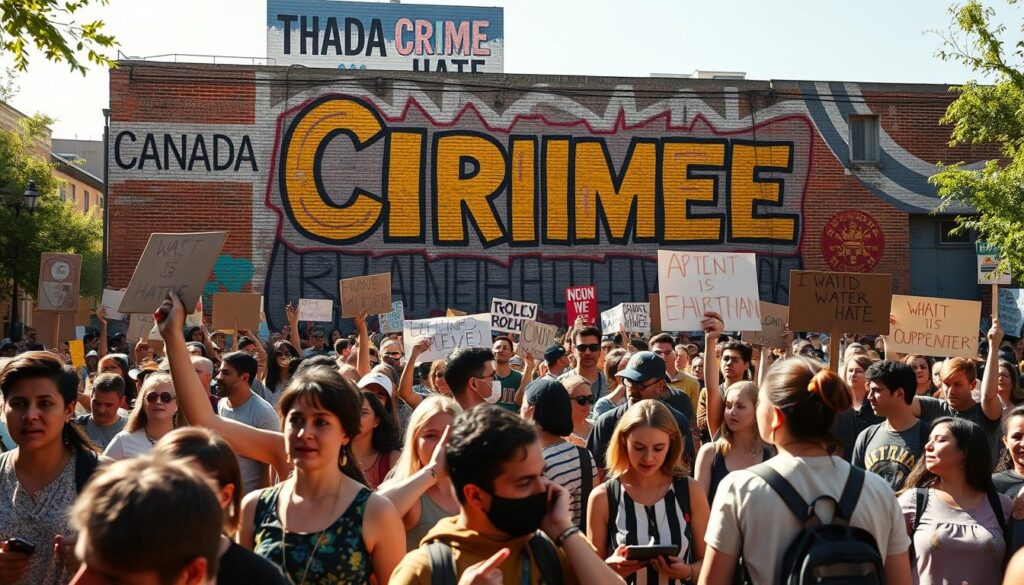Table of Contents
Did you know that hate crimes in Canada went up by almost 30% in 2020? This big rise shows we must act now to protect our neighborhoods. We need to know the dangers and how to stop them. By reading this, you will find out how to prevent hate crimes and make a difference in making our places more welcoming.
Understanding Hate-Motivated Mischief
Hate-motivated mischief falls under hate crimes and is a big threat to safety in various communities. It’s important to know what hate crimes are and see how they show up. This knowledge helps us spot and stop these harmful actions.
Definition of Hate Crimes
In Canada, hate crimes are acts against people or groups because of their race, ethnicity, religion, sexual orientation, or other traits. They include vandalism, threats, and physical attacks caused by bias. Knowing what hate crimes are is key to increasing awareness in the community.
How Hate-Motivated Mischief Manifests
The ways hate crimes appear are many and can affect anyone. These include:
- Graffiti or vandalism targeting specific religious sites or cultural landmarks
- Verbal abuse or threats directed at individuals based on their identity
- Physical assaults or bullying rooted in discriminatory beliefs
Being aware of these signs is important for everyone in the community. When we’re informed, we can step in effectively. This improves how we fight hate crimes together.
| Type of Hate Crime | Examples | Impact |
|---|---|---|
| Vandalism | Defacing places of worship | Instills fear and affects religious freedom |
| Verbal Abuse | Hate Speech | Psychological distress |
| Physical Assault | Attacks based on identity | Physical and emotional harm |
Current Statistics on Hate Crimes in Canada
It’s vital to know about hate crimes in Canada today. This helps us make our communities safer and more welcoming. Statistics Canada has found a worrying rise in these crimes. They’re driven by racism, religious hate, and bias against people’s sexual choices. Such acts deeply affect different groups in our society.

Recent Trends and Data
Looking at the latest data, hate crimes are on the upswing. For Black Canadians, the increase is especially sharp, mirroring a larger pattern seen across North America. Attacks on Jewish and Muslim people have gone up too. This shows we must keep a close watch and take steps to prevent such crimes.
“In 2020 alone, there was a 37% increase in reported hate crimes compared to the previous year,” according to Statistics Canada.
Impact on Various Communities
Hate crimes leave deep scars on communities in Canada. Those at greatest risk include racial minorities, religious groups, and LGBTQ+ people. They often feel more scared and worried. This fear can stop them from taking part fully in society. We must tackle these problems from every angle. By using laws and supporting each other, we can look after the safety and happiness of all Canadians.
Legal Framework in Canada
The Canadian Criminal Code has rules to stop hate crimes, protecting everyone from hate-driven acts. By learning about these rules, you’re better set to spot and report hate acts.
Criminal Code Provisions
The Canadian Criminal Code targets crimes fueled by hate. It singles out these acts, showing their unique harm. Important sections are:
- Section 319(1): Public incitement of hatred.
- Section 319(2): Willful promotion of hatred.
- Section 430(4.1): Mischief relating to religious property.
These sections lay down tough punishments for hate-driven mischief, underlining the acts’ seriousness.
Reporting Mechanisms
It’s crucial to have good ways to report hate crimes. There are many ways to report, ensuring quick documentation and investigation. When you see or are a victim of hate crimes, you should:
- Contact local law enforcement: Share what happened, where, and who was involved.
- Utilize online reporting tools: Online forms offer a fast and private way to report.
- Use community-based organizations: These groups help with the reporting steps and provide support.

Reporting accurately helps law enforcement understand and fight hate crimes better.
Tips to Prevent Hate-Motivated Mischief
To stop hate-motivated mischief, we need to act before things happen. We can do this by getting the community involved, teaching everyone, and using technology wisely. Doing these things can make our community safer and welcome everyone.

Community Engagement
Getting everyone in the community involved is a key step. Ask people to join in on activities and local events that bring us together. Open lines of communication help build trust and teamwork. This makes it easier to spot and solve issues.
Educational Programs
Education plays a big role in stopping hate speech. Start teaching about diversity, respect, and acceptance early on. This will build a community where everyone feels included. Offering workshops and awareness campaigns gives us tools to stand up against hate.
Technology’s Role
Technology can also help in fighting hate. Use social media and apps to share positive messages and report bad behavior. They can also give education and help to those who need it. Using tech in these ways makes our neighborhoods safer for everyone.
Support for Victims and Survivors
When hate crimes happen, it’s very important to help those hurt by these actions. In Canada, many programs help victims start to heal. They offer emotional support, guide them through legal issues, and give practical advice.
Advocacy for tolerance is also key in these support efforts. By promoting understanding and acceptance, communities can fight against hate crimes. Knowing about these support services helps victims and makes our society safer and more welcoming.

Many groups work together to support those affected by hate. They provide counseling, financial help, and helplines so no one has to face this alone.
“Supporting victims through advocacy for tolerance and effective victim assistance programs is essential in dismantling the cycle of hate and fear,”
This quote from Canada’s advocacy groups is very important.
Communities keep talking and taking action to help victims of hate crimes. They work together to create a place where everyone can recover and feel safe. This commitment builds a stronger, more supportive community for everyone.
Promoting Inclusivity in Your Community
Making everyone feel welcome is key. We start by encouraging inclusivity so everyone feels important. We do this by setting up inclusive community activities and championing a leadership that reflects diversity.
Inclusive Events and Activities
Building an inclusive environment means hosting events for everyone. We can have cultural festivals, sports, or workshops. Every activity should welcome all kinds of people. Make sure to get ideas from diverse groups to ensure real inclusivity.

- Host multicultural festivals that celebrate various traditions.
- Include recreational activities that are accessible to people of all abilities.
- Organize community dialogues to discuss and address the needs of minority groups.
Diverse Representation in Leadership
Having diverse leaders helps our community. It lets many viewpoints be heard, especially in big decisions. We push for more variety by getting more people from different backgrounds into leadership spots.
Here are ways to achieve diversity in leadership:
| Leadership Role | Current Representation | Target for Diversity |
|---|---|---|
| City Council | 20% women, 10% minority | 50% women, 30% minority |
| School Board | 30% diverse backgrounds | 50% diverse backgrounds |
| Community Organization Heads | 15% underrepresented groups | 40% underrepresented groups |
By focusing on promoting inclusivity, we can make our community a place where everyone is welcomed, valued, and respected.
Collaborating with Law Enforcement
Working together with law enforcement is key to fighting hate crimes in your area. By partnering with police, communities can be safer, get help quickly, and feel more secure.
Building Trust and Partnerships
Building trust with the police takes time and effort. Start by having meetings with local officers to talk about what worries your community and share important news. Also, hold events where people can meet the police in a friendly way.

Effective Communication Strategies
Talking to the police should be straightforward, ongoing, and positive. Use different ways like town hall gatherings, social media, and community boards to share updates and listen to what others have to say.
Promoting respect between the community and police makes everyone feel valued. A community liaison officer can help make sure both sides work well together.
| Strategy | Description | Benefits |
|---|---|---|
| Regular Meetings | Session between community leaders and law enforcement | Enhances transparency and mutual understanding |
| Joint Community Events | Events that encourage interaction between police and residents | Builds trust and showcases the human side of law enforcement |
| Community Liaison Officer | Appointed officer to act as a bridge between police and community | Improves communication and eases conflict resolution |
The Role of Online Platforms
Today, online platforms are key in shaping public talk. They let users share information, ideas, and opinions quickly. This has both good and bad sides.
These sites can be places for everyone to share ideas. But, they can also spread hate speech which harms people.
Combating Online Hate Speech
To keep the internet safe, platforms must fight hate speech. Facebook, Twitter, and YouTube try to remove hate by setting rules. Yet, keeping up is hard because of all the content online.
They use technology and more people to catch bad words. They also let users help by reporting mean content. This helps make the internet safer.

Promoting Positive Content
Encouraging good stuff online is important for friendly digital places. Sharing happy stories and kind words helps fight online meanness. Pinterest and Instagram show how to bring positivity to users.
This not only makes us feel better but helps everyone get along better. It’s about spreading good vibes and understanding.
Having freedom while keeping the internet safe is a tricky balance. Fighting hate and supporting good content makes sure all voices are heard with respect.
| Platform | Anti-Hate Policies | Positive Content Initiatives |
|---|---|---|
| Community Standards | Hate Speech Research | |
| Hateful Conduct Policy | Twitter Spaces | |
| YouTube | Harassment and Cyberbullying Policy | YouTube Learning |
| Community Guidelines | Kindness Prompts |
Grassroots Initiatives to Combat Hate
Grassroots movements powerfully tackle societal issues, especially hate. They center on local action by community members keen to promote inclusivity and fight hate crimes. Such movements include the efforts of anti-racism groups. They organize workshops, campaigns, and events to educate and unify people against intolerance.

Communities are coming together to support marginalized individuals. They set up safe spaces and support networks. Things like neighborhood watches help prevent hate acts and bring people together. These groups often work with police to help victims and stop crimes before they happen.
Schools are also getting involved by teaching kids about diversity and empathy early on. Through fun lessons and activities, children learn to value everyone’s differences. This education builds a base for a future where everyone is accepted.
Grassroots movements swiftly act to support victims of hate crimes. They organize fundraisers, help rebuild, and offer mental health support. These actions show how communities can offer quick and impactful help to those hurt by hate acts.
The real impact of grassroots work is the change it sparks from within. By focusing on local efforts, these movements tackle hate’s symptoms and its causes. This paves the way for a society where people live together in harmony.
Acknowledging and Respecting Indigenous Communities
Respecting Indigenous communities is crucial for fighting hate and increasing inclusivity in Canada. Moving towards Indigenous reconciliation is key for building respectful, lasting relationships.
Importance of Reconciliation
Reconciliation is more than a single act. It is a continuing effort to recognize past wrongs and to strive for respectful relations. By learning about the history of Indigenous peoples and the effects of colonization and residential schools, we can lay the groundwork for trust. Indigenous reconciliation helps with healing and strengthens communities against hate.
Cultural Awareness and Education
It is vital to teach and understand Indigenous cultures. Creating cultural awareness programs and educating on these cultures helps break down stereotypes and biases. Programs can include workshops, school lessons, and events that celebrate Indigenous traditions and languages.
Events showcasing Indigenous art, dance, and stories not only enrich our community but also connect different cultures. Through these efforts, we cultivate deeper respect and empathy towards Indigenous communities, leading to a more inclusive society.
Federal and Provincial Support Programs
Canada is fighting hate crimes with strong federal support programs. These programs help communities by giving them what they need to prevent and handle hate crimes. It’s all about offering crucial support and resources.
Funding Opportunities
The government is investing $214 million up to 2026. This money supports prevention and helps victims of hate crimes. They are making sure communities get funds to help local groups. Another $45 million is being used to study crimes related to gender or identity. This helps understand these crimes better and respond more effectively.
The Canada’s Action Plan on Combatting Hate highlights working together and using data to fight hate. You can read more about it on the official Canadian government website. It shows how important it is for everyone to work together against hate.
Resources for At-Risk Communities
There’s a lot of help for communities that might be targeted by hate crimes. For example, Ontario’s Anti-Racism Directorate keeps track of hate crimes on platforms like canadacrime.ca. This helps them act quickly where it’s needed most. Such efforts are key to reducing hate crimes.
In British Columbia, outreach teams cut down repeat hate crimes by 33% in some areas. This shows that focusing on certain areas can work. In Ontario, workshops led by locals lowered repeat incidents by 41%. This proves community actions are powerful in fighting hate.

Conclusion
Fighting hate needs teamwork beyond just one person. It requires the work of every part of our community. It’s important to understand hate’s deep impact and push for kindness. We also need to take strong steps to stop hate before it starts.
Building strong community bonds is key. This involves getting involved, learning, and including different leaders. These actions make everyone feel they belong. They help build a place where we’re all safe and valued.
Working together, communities, police, and online spaces can fight hate. Sharing information well and building trust is crucial. This way, we can stop hate early and help those it hurts. Online spaces need to fight hate speech but also share positive messages.
Finally, to really protect Canada from hate, all levels of government and communities must be dedicated. Using support programs, ground-level efforts, and promoting understanding can make a difference. We envision a future where everyone feels included and secure. Let’s all work together for a kinder, stronger community.

